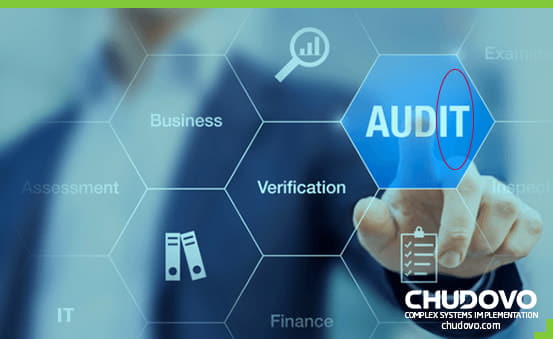
Master the Power of IT Audit: A Comprehensive Guide for Business
In the digital world today, data has become the lifeblood of organizations, fueling innovation, driving decision-making, and enhancing customer experiences. However, with the rising significance of data, the need to safeguard it from cyber threats and breaches has never been more critical.
This is where IT audits emerge as a potent force, empowering businesses to fortify their data security, ensure regulatory compliance, and align their IT infrastructure with strategic objectives.
This comprehensive guide embarks on a transformative journey through IT audits. We delve into the core principles, methodologies, and best practices that underpin the audit process, unraveling the steps organizations must take to navigate this landscape successfully.
From understanding the fundamentals of IT audits to exploring their pivotal role in shaping business strategy and resilience, we leave no stone unturned in uncovering the potential of IT audits. With knowledge and insights, business owners and decision-makers can confidently implement effective IT audit practices, safeguarding their digital assets and paving the way for sustainable growth and success.
Join us in this exciting journey as we explore the world of IT audits – what they are, why they matter, and how they can revolutionize your business’s security. Get ready to discover the key to unlocking a safe and successful digital future. Let’s dive in!
Table of Content
- Getting Started with IT Audits
- What Is the IT Audit Process & What Should You Expect?
- 7 Best Practices for IT Audits and How to effectively implement them
- Highlight 5 roles IT audit plays in achieving Data Privacy and Regulatory Compliance
- Tips for Aligning IT Audits with Cybersecurity Strategies
- Conclusion
- FAQs
Understanding IT Audit
An IT audit is a meticulous and systematic examination of an organization’s information technology systems, processes, and controls. As businesses rely heavily on technology for their day-to-day operations, IT audits provide critical insights into the efficiency, reliability, and security of an organization’s IT environment.
IT audits leave no stone unturned, from the hardware and software components that underpin a company’s infrastructure to the myriad digital processes that govern data flow and user access. This comprehensive approach enables businesses to identify vulnerabilities, detect potential risks, and uncover opportunities for process optimization and resource allocation.
Why IT Auditing is Indispensable in the Digital Era

In today’s hyper-connected and data-centric world, businesses face complex challenges that demand robust risk management and stringent security measures. The rising tide of cyber threats, stringent regulatory requirements, and the ever-increasing demand for data privacy necessitate a proactive and dynamic approach to IT governance.
Here are some compelling reasons why IT auditing is an indispensable practice for every forward-thinking business:
- a) Proactive Risk Mitigation: IT audits empower organizations to identify potential risks and vulnerabilities before they escalate into a full-blown crisis. By proactively addressing weaknesses in IT infrastructure and processes, businesses can minimize the impact of potential threats and disruptions.
- b) Strengthened Security Posture: In an age where data breaches and cyberattacks are rampant, IT audits are a powerful ally in fortifying an organization’s security posture. By evaluating existing controls and protocols, businesses can ensure that their sensitive data remains protected from unauthorized access and exploitation.
- c) Compliance and Regulatory Adherence: Businesses operate within a complex web of industry regulations and data privacy laws. IT audits are pivotal in verifying compliance with these legal obligations, safeguarding businesses from potential penalties and reputational damage.
- d) Enhanced Decision-making: By providing a comprehensive overview of the IT landscape, audits empower business leaders to make data-driven decisions. Understanding the strengths and weaknesses of IT systems enables leaders to allocate resources strategically and drive meaningful improvements in business processes.
Certified engineers Convenient rates Fast start Profitable conditions Agreement with English and German
EU company
speaking engineers
Benefits of IT Audits
Delving deeper into the realm of IT audits, let us explore the manifold benefits they bestow upon businesses of all sizes and industries:
- a) Reducing Organizational Risk: IT audits systematically identify potential risks and threats, allowing businesses to implement proactive measures to mitigate them. Organizations can bolster their resilience and prepare for unexpected challenges by prioritizing risk reduction.
- b) Strengthening Controls and Defenses: Audits shed light on the effectiveness of existing controls and security measures. This enables organizations to fortify their defenses, stay one step ahead of cyber threats, and ensure data confidentiality, integrity, and availability.
- c) Complying with Evolving Regulations: Adherence to data protection and privacy regulations is a non-negotiable aspect of modern business operations. IT audits ensure that businesses comply with the latest regulatory requirements, minimizing the risk of penalties and legal complications.
- d) Facilitating Effective Communication: IT audits foster transparent and constructive communication between IT departments and business stakeholders. This alignment of objectives and understanding risks leads to enhanced collaboration and a unified approach to achieving business goals.
Challenges and Strategies in Conducting Effective IT Audits
While IT audits offer immense value to businesses, they are not without their share of challenges. This section will address some of the common hurdles faced during the IT audit process and provide practical strategies to overcome them. By understanding and navigating these challenges, businesses can ensure the successful implementation of IT audits and reap their full benefits.
Lack of Clarity in IT Governance
One of the primary challenges faced during IT audits is the lack of clarity in IT governance structures within organizations. Transparent governance ensures that IT operations align with business objectives and regulatory requirements. Without a well-defined IT governance framework, businesses may encounter inconsistencies, redundancies, and inefficiencies in their IT processes.
Strategy: To overcome this challenge, organizations must establish robust IT governance frameworks that outline roles, responsibilities, and decision-making processes. Define clear reporting lines and empower IT leaders to make informed decisions in alignment with overall business objectives.
Resource Constraints and Expertise Gaps
Conducting comprehensive IT audits demands time, expertise, and resources. Smaller businesses or those with limited IT capabilities may find it challenging to dedicate the necessary resources to conduct thorough audits. Moreover, finding skilled auditors with a deep understanding of evolving IT risks can be daunting.
Strategy: To address resource constraints, businesses can consider outsourcing their IT audits to reputable third-party auditors like Chudovo with specialized expertise. These external auditors bring a fresh perspective and can provide valuable insights into the organization’s IT practices.
Rapid Technological Advancements
The pace of technological advancements poses a considerable challenge for IT audits. Emerging technologies, such as cloud computing, artificial intelligence, and the Internet of Things (IoT), introduce new risks and complexities that auditors must address effectively.
Strategy: Organizations should invest in continuous training and development for their IT staff to keep them updated on emerging technologies and their associated risks. Encourage auditors to engage in ongoing professional development to stay ahead of the technology curve.
Resistance to Change
IT audits may reveal the need for significant process improvements or changes in IT practices. Resistance to change from employees can impede the successful implementation of audit recommendations.
Strategy: To overcome resistance, foster a culture of openness to change within the organization. Emphasize the positive outcomes that these improvements will bring, such as enhanced security, streamlined operations, and increased efficiency.
Balancing Business Priorities and Auditing Needs
Businesses operate in dynamic environments with constantly shifting priorities. It can be challenging to find the right balance between conducting thorough IT audits and addressing day-to-day operational demands.
Strategy: Plan and schedule IT audits strategically to align with periods of lower operational intensity. Communicate the importance of audits to all stakeholders, emphasizing that they contribute to long-term success and resilience.
Getting Started with IT Audits

To get started with IT auditing as a business entity, here is some things worth noting:
Types of IT Audits
IT audits come in various forms, including but not limited to:
- a) Compliance Audits: These audits ensure adherence to relevant laws, regulations, and industry standards.
- b) Security Audits: Evaluating the security measures and protocols to safeguard critical data and systems from unauthorized access.
- c) Performance Audits: Assessing the efficiency and effectiveness of IT processes and practices to optimize business operations.
- d) Systems Development Audits: Reviewing the development and implementation of new IT systems to identify potential risks.
Key Principles of IT Auditing
To conduct successful IT audits, adherence to the following principles is essential:
- a) Independence and Objectivity: Auditors must remain independent and objective, free from bias or conflict of interest.
- b) Due Professional Care: Auditors must exercise due diligence, competence, and care in performing their duties.
- c) Evidence-Based: All audit findings and recommendations should be supported by concrete evidence.
- d) Systematic Approach: IT audits follow a systematic methodology to ensure comprehensive coverage.
Pivotal Roles of IT Audits in Shaping Business Strategy and Resilience
IT audits play a pivotal role in shaping modern businesses’ strategic direction and overall resilience. As technology increasingly intertwines every aspect of organizational operations, IT audits offer invaluable insights that inform and empower strategic decision-making. In this section, we will explore five critical roles of IT audits in driving business strategy and resilience, demonstrating their significance as a linchpin in pursuing sustainable growth and success.
Risk Assessment and Mitigation
At the heart of effective business strategy lies a comprehensive understanding of risks and vulnerabilities. IT audits excel in assessing the digital landscape, identifying potential risks, and recommending appropriate mitigation strategies. By scrutinizing IT systems, networks, and applications, auditors uncover potential weaknesses that could expose the organization to cyber threats, data breaches, and operational disruptions. With this knowledge, business leaders can prioritize risk mitigation efforts and allocate resources to safeguard critical assets and operations.
Enhancing Cybersecurity Posture
Cybersecurity has emerged as a critical component of business strategy in an era dominated by cyber threats and sophisticated attacks. IT audits rigorously evaluate the efficacy of cybersecurity measures, including data encryption, access controls, and incident response protocols. By shedding light on areas requiring improvement, IT audits empower organizations to strengthen their cybersecurity posture, thereby reducing the likelihood of successful cyberattacks and fortifying their defenses against evolving threats.
Aligning IT with Business Objectives
Effective business strategy ensures seamless alignment between IT initiatives and overarching organizational goals. IT audits facilitate this alignment by assessing the efficiency and effectiveness of IT processes, systems, and applications in supporting business objectives. By highlighting areas where IT can be fine-tuned to enhance operational efficiency and drive innovation, IT audits guide the strategic deployment of technology to maximize its impact on overall business performance.
Ensuring Regulatory Compliance and Data Privacy
Compliance with data protection laws and industry regulations is non-negotiable in an increasingly stringent regulatory landscape. IT audits play a central role in verifying the organization’s adherence to these requirements, safeguarding against potential legal repercussions and reputational damage. By assessing data privacy practices, data handling procedures, and adherence to relevant compliance frameworks, IT audits enable businesses to demonstrate a commitment to ethical data management and responsible governance.
Facilitating Informed Decision-Making
Informed decision-making is the bedrock of effective business strategy. IT audits give decision-makers a comprehensive understanding of the organization’s IT infrastructure, data security, and risk exposure. With this knowledge, leaders can make well-informed choices about resource allocation, technology investments, and pursuing strategic opportunities. The insights gleaned from IT audits empower decision-makers to navigate complexities, seize competitive advantages, and steer the organization toward sustainable growth and success.
In summary, IT audits are multifaceted in shaping business strategy and resilience.
Who Performs an IT Audit?
IT audits can be conducted both internally and externally:
- Internal IT Audits: Performed by an organization’s IT staff, internal audits offer in-depth knowledge of the company’s operations and systems.
- External IT Audits: This is carried out by independent third-party auditors. External audits provide unbiased insights and validation of controls.
The IT Audit Process & What Should You Expect?

The IT audit process is a meticulously crafted journey that unveils the inner workings of an organization’s information technology landscape. Here, we embark on a comprehensive exploration of the IT audit process, dissecting each step with intricate detail and shedding light on what businesses should expect during this transformative assessment. Here is the 6-step process:
- Step 1: Meticulous Planning and Preparation
The foundation of any successful IT audit lies in meticulous planning and thorough preparation. During this crucial phase, auditors work closely with key stakeholders to define the audit’s objectives, scope, and criteria for evaluation. Clear communication and understanding between auditors and management ensure the audit aligns with business goals and regulatory requirements.
- Step 2: Delving into Risk Assessment
Risk assessment is a central pillar of the IT audit process. During this phase, auditors systematically identify potential risks, vulnerabilities, and threats that could impact the confidentiality, integrity, and availability of the organization’s data and IT systems.
- Step 3: Evaluating the Effectiveness of Controls
In this critical step, auditors evaluate the effectiveness of existing IT controls and security measures to protect against identified risks. Controls encompass policies, procedures, and technical mechanisms that safeguard IT systems and data from unauthorized access and misuse.
- Step 4: Compliance Review
Compliance with industry regulations and data privacy laws is paramount for modern businesses. IT audits undertake a rigorous compliance review to verify the organization’s adherence to relevant legal obligations and internal policies.
- Step 5: Vulnerability Assessment
As technology evolves, so do IT systems’ potential vulnerabilities and weak points. Vulnerability assessment is a key component of the IT audit process. It involves using specialized tools and techniques to identify potential weaknesses and points of exploitation in hardware, software, networks, and applications.
- Step 6: Reporting and Recommendations
In the culminating phase of the IT audit process, auditors compile their findings, observations, and analysis into a comprehensive audit report. This report serves as a roadmap for the organization’s IT teams, guiding them in implementing necessary changes and improvements to bolster security and efficiency.
9 Best Practices for IT Audits and How to Effectively Implement Them

Having covered the audit process, let us explore 9 best practices organizations can adopt to conduct effective IT audits and maximize their impact on business operations and security.
- Establish Clear Objectives
Define the objectives of the IT audit from the outset, ensuring they align with the organization’s broader goals. Clarity of purpose ensures a focused and meaningful audit.
- Maintain Independence and Objectivity
To uphold the integrity of the audit process, auditors must remain independent and objective, free from any bias or conflicts of interest.
- Use Established Audit Frameworks
Leverage recognized audit frameworks, such as COBIT (Control Objectives for Information and Related Technologies) or ISO 27001 (Information Security Management System), to ensure a structured and standardized audit approach.
- Adequate Planning and Preparation
Thorough planning and preparation are essential for a successful IT audit. Ensure auditors have access to all necessary information and resources to conduct a comprehensive assessment.
- Conduct Risk Assessment and Control Testing
Perform a thorough risk assessment and test the effectiveness of existing controls to identify potential weaknesses and gaps in the IT environment.
- Document Findings and Recommendations
Document all audit findings, observations, and recommendations in a clear and concise manner. The report should provide actionable insights for stakeholders to implement necessary improvements.
- Continuous Learning and Improvement
Encourage continuous learning and professional development for IT staff and auditors to stay updated on emerging IT risks and trends.
- Follow-Up and Monitoring
Regular follow-up and monitoring of audit recommendations are vital to track progress and ensure that improvements are sustained over time.
- Maintaining IT Audit Records
Properly maintain all IT audit records, ensuring they are readily accessible for future reference, compliance requirements, and regulatory purposes.
By incorporating these best practices into their IT audit processes, businesses can optimize the value of audits and fortify their security and risk management practices.
Role IT Audit Plays in Achieving Data Privacy and Regulatory Compliance
IT audits play a critical role in ensuring data privacy and regulatory compliance by:
- Іdentifying Vulnerabilities: IT audits help identify potential security vulnerabilities that could compromise sensitive data.
- Evaluating Controls: Auditors assess the effectiveness of data protection controls and recommend improvements.
- Іnsuring Compliance: IT audits verify compliance with data protection laws and industry regulations.
- Safeguarding Sensitive Information: By strengthening IT security measures, audits safeguard sensitive business and customer data.
Tips for Aligning IT Audits with Cybersecurity Strategies
To align IT audits with cybersecurity strategies effectively, consider the following tips:
- Collaboration: Foster collaboration between IT auditors and cybersecurity teams to create a unified approach.
- Continuous Assessment: Conduct regular IT audits to keep pace with evolving cybersecurity threats.
- Risk Prioritization: Prioritize cybersecurity risks based on their potential impact on business operations and data security.
- Training and Awareness: Educate employees about cybersecurity best practices and their role in maintaining a secure IT environment.
Conclusion
In conclusion, mastering the power of IT audit is imperative for businesses seeking to thrive in the digital age. IT audits identify potential risks and enable organizations to enhance their data security, comply with regulations, and align technology initiatives with broader business strategies. By implementing the best practices outlined in this guide, business owners can confidently navigate the complex landscape of IT audits and safeguard their valuable digital assets.
However, as technology continues to shape the business landscape, the importance of IT audits cannot be overstated. Businesses prioritizing IT audits gain a competitive advantage, robust security, and the ability to adapt effectively to evolving challenges.
FAQs
Q1: How often should businesses conduct IT audits?
A1: The frequency of IT audits depends on various factors, including the organization’s size, industry, and risk profile. Generally, businesses should conduct IT audits annually, with more frequent assessments for high-risk sectors.
Q2: Can small businesses benefit from IT audits?
A2: Absolutely! Small businesses can significantly benefit from IT audits as they often lack the extensive resources of larger enterprises. IT audits can identify vulnerabilities and improve data security, even on a limited budget.
Q3: Should organizations conduct internal or external IT audits?
A3: Both internal and external audits have their advantages. Internal audits provide valuable insights due to their intimate knowledge of the organization, while external audits offer unbiased perspectives and independent evaluations.
Q4: What are some emerging IT audit trends to watch out for?
A4: Emerging IT audit trends include increased focus on data analytics to identify patterns and trends, audit process automation, and cloud-based infrastructure and services auditing.
Do you have a query about our IT audit services, or would you like to talk to a Chudovo representative? Please fill out the form in this link to get in touch!



